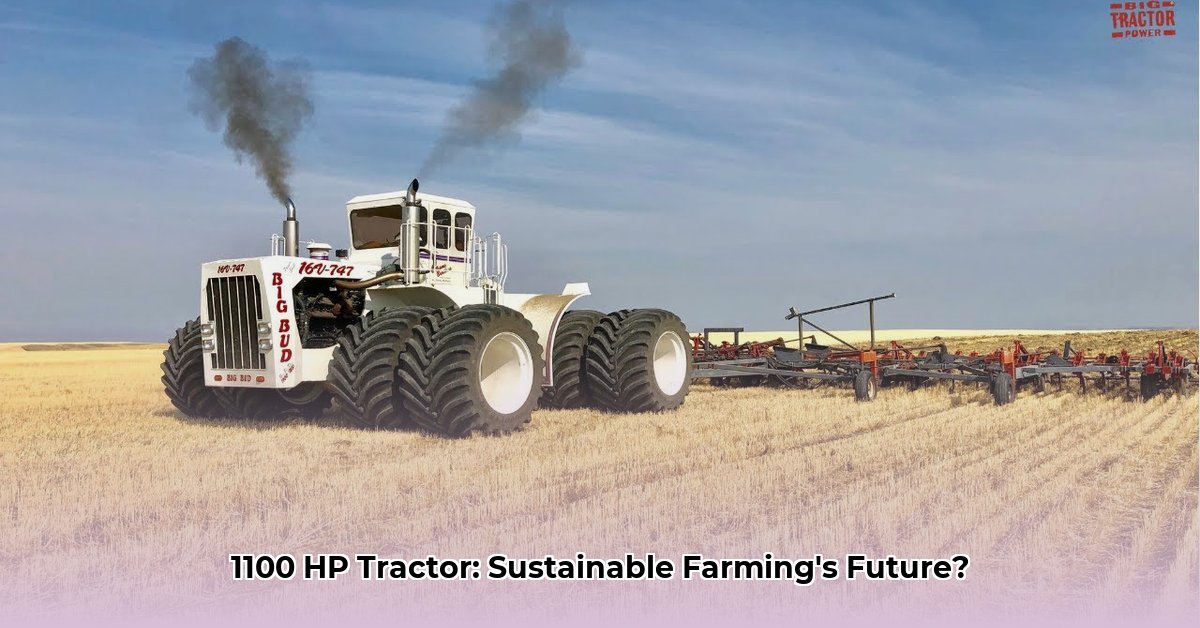
1100 hp Tractor: A Giant Leap in Farming, and a Look Back
The concept of an 1100-horsepower tractor evokes images of immense power and efficiency. While the Massey Ferguson (MF) 1100 itself didn't reach such levels, its impact on farming practices and its relevance to modern sustainable agriculture warrant a closer examination. This case study explores its design, fuel efficiency (relative to today's standards), and its legacy in shaping contemporary agricultural technology's trajectory towards sustainability. How can a tractor from decades past provide actionable intelligence for today's eco-conscious farming? For more on tractor history, check out this great resource.
Fueling the Fields: Then and Now
Unlike most modern tractors primarily reliant on diesel, the MF 1100 offered farmers a choice: gasoline, liquid petroleum gas (LPG), or diesel. This flexibility, while a reflection of the fuel landscape of its era, raises questions regarding its implicit sustainability. Did this fuel versatility represent a proactive approach to environmental considerations, or merely a reflection of available technology and fuel supply? Precise fuel consumption data per acre is challenging to acquire, making direct comparisons to modern tractors problematic. However, the varied fuel options demonstrate a broader consideration of energy sources than is common today.
Power Play: Strength vs. Efficiency
While the MF 1100's horsepower was impressive for its time, it pales in comparison to the capabilities of current 1100 hp tractors. Does this necessarily signify lower efficiency? Not necessarily. Simpler designs potentially translated to lower energy consumption during manufacturing. However, the lower power of the MF 1100 likely necessitated more passes across the field to complete a task, potentially increasing overall fuel expenditure and time. This highlights that raw power isn't the sole determinant of efficiency; the efficiency of work completed per unit of fuel expended should also be considered.
Simple Machines, Lasting Impact?
The MF 1100's mechanical systems appear rudimentary by today's standards, but this simplicity offers benefits relevant to sustainability: fewer components translate to a smaller material footprint during production, potentially easier repairs, and potentially a longer operational lifespan. This suggests a valuable design principle for modern agriculture: Could streamlined, durable designs lead to less waste and extend the lifespan of farm machinery, reducing the environmental burden of continual replacement?
Lessons from the Past, Seeds for the Future
The MF 1100's legacy underscores critical considerations for sustainable agriculture:
- Fuel Diversity: The exploration of alternative fuels such as biodiesel needs renewed attention to reduce dependence on fossil fuels.
- Durability and Repair: Building robust, easily repairable machinery is crucial in minimizing waste and resource depletion.
- Precision Farming's Influence: Modern high-horsepower tractors, enabled by precision agriculture techniques, offer improvements in fuel efficiency and resource management. However, this underscores that increased power doesn't automatically equate to enhanced sustainability; efficient application of power is paramount.
How to Compare Massey Ferguson 1100 Fuel Efficiency to Modern Tractors
Direct comparison of the MF 1100's fuel efficiency to that of modern tractors is complex due to discrepancies in technology and testing methodologies. This section explores the challenges and proposes indirect approaches to evaluating relative fuel economy.
Understanding the 1100's Engine
The MF 1100 typically employed Perkins diesel engines known for their durability. However, these engines lacked the sophisticated fuel injection systems and electronic controls present in modern engines. These technological differences significantly impact fuel efficiency calculations.
Fuel Efficiency Metrics: Then and Now
Direct fuel consumption comparisons are hampered by variations in testing standards and operating conditions of different eras. Several factors must be considered: horsepower, engine technology, implement usage (e.g., plowing versus harrowing), and even soil conditions. These factors complicate straightforward assessments of fuel economy. In order to efficiently make comparison, we must consider:
- Horsepower Output: Modern 1100 hp tractors often leverage multiple engine technologies, surpassing the MF 1100 significantly in raw power.
- Engine Technology: Advanced fuel injection, turbocharging, and electronic controls dramatically improve efficiency and reduce emissions in modern engines.
- Operational Practices: Precision agriculture utilizing GPS and variable-rate technology greatly effect fuel consumption.
Indirect Comparisons & Contextual Clues
Despite the challenges of direct comparisons, qualitative data from user forums and owner testimonials provide valuable insights. These sources offer anecdotal information on relative fuel consumption, providing a contextual understanding of efficiency relative to workload. For instance, a modern tractor might complete a field operation in significantly less time than the MF 1100, potentially offsetting its potentially higher fuel consumption per hour.
Making Sense of the Data
Determining the MF 1100's fuel efficiency requires a nuanced approach. While its fuel efficiency was commendable for its time, modern tractors, through advancements in technology and design, have achieved superior performance—especially concerning completed work per unit fuel consumption. Understanding the historical and technological context is crucial for meaningful comparative analysis.